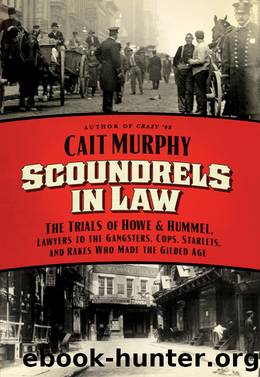Scoundrels in Law by Cait N. Murphy

Author:Cait N. Murphy
Language: eng
Format: epub
Publisher: HarperCollins
Johann Most was a more consequential, and controversial, figure than the sociable Schwab. Born in Germany, Most was scarred for life when an operation for an infected jaw left his face permanently twisted. The disfigurement did nothing to soothe a combustible temperament; at the age of 12, he organized his first strike, against an unpopular teacher, and was expelled from school. It would become a pattern. He bounced around northern Europe, wearing out his welcome first in Austria, and then in Germany, where he was arrested for a speech that was overenthusiastic about the utility of explosions as a form of political discourse. Moving to London, he started a newspaper, Freiheit (Freedom), that was extreme enough to get him expelled from the Social Democratic Party. It was about this time that he picked up the nickname of âGeneral Boom Boom.â
Most might have been able to beaver away indefinitely on the margins, if Freiheit had not gloated over the assassination of Alexander II in 1881. âAt last he died like a dog,â Most concluded of the czar. It was too much for Britain, which had its own royal family and problems with bomb throwers. He did another stint in jail.
On his release, he took up Schwabâs invitation to come to the United States, arriving in late 1882. Taking up the reins of Freiheit again, Most quickly established himself as the face of anarchism, which at the time was regarded as something of an inside joke that Europeans played on each other. Most was a ferocious and stirring presence, by all accounts, who favored what he called the attentat, or âpropaganda of the deed.â The practicalities of this he addressed in 1885, with the publication of his most famous work: The Science of Revolutionary Warfare: A Little Handbook of Instruction in the Use and Preparation of Nitroglycerine, Dynamite, Gun-Cotton, Fulminating Mercury, Bombs, Fuses, Poisons, Etc., Etc. The book won a devoted following among arsonists and insurance scammers, but it cost Most his friendship with Schwab, who failed to see arson-for-hire as an appropriate revolutionary tool.
Americaâs bemused tolerance of the anarchists expired in the bloody chaos of Haymarket Square in Chicago on May 4, 1886. An anarchist-organized rally for the eight-hour workday began peacefully. Police moved in to break it up around 10:30; a pipe bomb was thrown, and police fired into the crowd. When the smoke cleared, eight policeman and four protesters were dead, and scores injured. It was a terrible day, but how the blame should be apportioned was impossible to determine.
At the time, though, the immediate reaction was to blame the radicals for everything. âThe villainous teachings of the Anarchists bore bloody fruit in Chicago tonight,â began the New York Times account of the tragedy, âand before daylight at least a dozen stalwart men will have laid down their lives as a tribute to the doctrine of Herr Johann Most.â
Most wasnât even in Chicago, and he couldnât have cared less about the eight-hour day.25 But as the most high-profile anarchist in America, he was going to pay for Haymarket.
Download
This site does not store any files on its server. We only index and link to content provided by other sites. Please contact the content providers to delete copyright contents if any and email us, we'll remove relevant links or contents immediately.
Hit Refresh by Satya Nadella(8344)
When Breath Becomes Air by Paul Kalanithi(7273)
The Girl Without a Voice by Casey Watson(7271)
Do No Harm Stories of Life, Death and Brain Surgery by Henry Marsh(6342)
A Court of Wings and Ruin by Sarah J. Maas(6110)
Hunger by Roxane Gay(4232)
Shoe Dog by Phil Knight(4181)
Everything Happens for a Reason by Kate Bowler(4074)
A Higher Loyalty: Truth, Lies, and Leadership by James Comey(4038)
The Rules Do Not Apply by Ariel Levy(3913)
Tuesdays with Morrie by Mitch Albom(3838)
The Immortal Life of Henrietta Lacks by Rebecca Skloot(3832)
How to Change Your Mind by Michael Pollan(3686)
Millionaire: The Philanderer, Gambler, and Duelist Who Invented Modern Finance by Janet Gleeson(3575)
All Creatures Great and Small by James Herriot(3526)
Elon Musk by Ashlee Vance(3460)
Tokyo Vice: An American Reporter on the Police Beat in Japan by Jake Adelstein(3441)
Man and His Symbols by Carl Gustav Jung(3325)
The Money Culture by Michael Lewis(3291)
